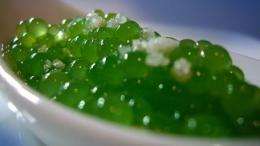Molecular celebrations for your taste buds

Not another turkey, caviar or Yule Log! What if the traditional end-of-year feast was left up to scientists? The menu might surprise a few...
Care for a bit of science for the festive season? How about fake caviar for starters, followed by turkey cooked in the dishwasher and laced with an orange emulsion, to end with an eggless and creamless chocolate mousse for dessert? These original dishes were born of a round trip from our Christmas tables to molecular gastronomy labs.
Kit caviar
Fake caviar is much more fun than the real stuff! Thanks to two ingredients found in specialist stores – sodium alginate (extracted from brown algae) and calcium lactate – you can produce minute balls which are crunchy outside with a liquid core and look just like the original fish eggs. If you add a flavour (e.g. caviar, why not?) and food colouring, your taste buds won’t know the difference!
This is really easy to make. Just use a syringe to feed droplets of alginate into the calcium lactate at room temperature. They instantly turn into small beads, as the calcium ions bind the alginate chains together just like glue. The result is a gel which captures the liquid droplets. “A bit of practice is in order if you don’t want your caviar balls to be the size and texture of green peas”, says Marc Heyraud, a specialist in molecular gastronomy at the Institute of Chemistry of Neuchâtel University.
Dishwasher-cooked turkey
Ultra-slow cooking at a temperature between 60 and 70°C is getting more and more popular. One the one hand, it avoids killing vitamins and amino acids and, on the other, it produces very tender meat. The collagen binding cells within muscle tissue deteriorates at a temperature as low as about 60°C and moisture clearly evaporates slower at 70°C than 150°C. Perfect balance can only be reached with slow cooking. In practice, this can be done in a normal (convection) oven preheated to a temperature just a few degrees above the chosen heat. A turkey should stay in for at least four hours.
A more original and energy-saving alternative is to cook your turkey in the dishwasher. This is not as crazy as it sounds, as great chefs have successfully tested this solution put forward by chemist Hervé This, a pioneer in molecular gastronomy. Provided of course that the bird is sealed in a watertight bag... You will need to put it in the oven for a few minutes to give it its tasty-looking roasted finish.
Let’s top it all off with an orange emulsion. As everyone knows, for mayonnaise you need a tensioactive agent from egg yolk, fat (oil), and water from vinegar and the egg. Marc Heyraud suggests substituting melted turkey fat, an egg white and orange juice.
Caviar and white chocolate
Can the right wine be scientifically selected to ensure that a given sugar content or soil is the perfect match for a given dish? Some studies by Heston Blumenthal, a leading figure in molecular gastronomy, tend to prove that two products are better suited to each other when they have as many aromatic compounds in common as possible. For instance, he tried combining caviar with white chocolate. Marc Heyraud, who tasted the surprising mixture, found it impressive. However, he doubts that the method could become widespread and considers that “Maybe what he has is the flair of great cooks, who dare to marry such different flavours and obtain great results. When you associate flavours, nothing is as reliable as tradition and experience, and this is how you find the right wine for a particular dish”.
Change of state for dessert
To impress your guests with a stylish, yet light and quickly-made dessert, why not try a mousse with just chocolate and orange juice or tea? Simply whisk the melted chocolate with either liquid on a bed of ice. The change from the liquid to the solid state through cooling captures the air bubbles produced by the whisk.
Provided by Ecole Polytechnique Federale de Lausanne

















